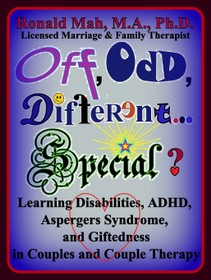Conclusion: Learning=Study+Practice - RonaldMah
Ronald Mah, M.A., Ph.D.

Licensed Marriage & Family Therapist,
Consultant/Trainer/Author
Main menu:
Conclusion: Learning=Study+Practice
Therapist Resources > Therapy Books > Odd Off Different-Cpl

Off, Odd, Different… Special? Learning Disabilities, ADHD, Aspergers Syndrome, and Giftedness in Couples and Couple Therapy
Conclusion: LEARNING IS STUDY AND PRACTICE

Certain individuals have aptitudes that make functioning extremely hard. They appear to others including their partners as off, odd, different, or special. Yet many such people are successful nevertheless because they work significantly harder than their less challenged peers. For individuals with ADHD, ADD, learning disabilities, or giftedness the hard thing may be to find a successful fit for their energy and strengths. It becomes easier to be them when their experiences are recognized and accepted. Motivating academic and vocational situations for ADHD individuals would be where high physical energy, motor-kinesthetic abilities, frequent changes, and/or short-term focus (vs. extended attention) are assets rather than detriments. Situations that accentuate strengths and allow compensation for weaknesses support individuals with learning disabilities. Individuals with Aspergers Syndrome, as is true for all individuals cannot learn social proficiency by avoiding practicing social situations. Individuals with gifts in some area or areas need to learn how to function among less gifted persons, maintaining personal integrity while avoiding being dismissive of them.

Trying harder is not always sufficient, so trying differently becomes critical. This may be important in particular in the intimate relationship. Off, odd, different, or special characteristics otherwise tolerated or submerged in work or less intimate social circumstances, can intensify in couple's dynamics despite trying hard and harder. Rather than make it easy for challenged individuals, the therapist needs to make it "hard" for them by requiring them to try differently. Avoiding instinctive and habitual responses that have not worked may be the hardest challenge. Therapy requires the partners to alter their social practice. Practice doesn't always make perfect, but makes for lots of mistakes while hopefully, developing greater proficiency. Practice moreover is critical for learning. Chinese calligraphy often has two words written together with the interplay between them creating meaning.

The calligraphy for "learning" is composed of word or symbol for "study" on the top and the word or symbol for "practice" on the bottom. Study, including of one's mistakes and considering alternatives works in conjunction to facilitate learning. Study for individuals such as Brody and Faith, Marc and Debra, or Gus and Bruce would involve examining giving and receiving social cues and personal processing. Partners in general will be directed to attending carefully to the messages and verbal and non-verbal cues that form the affective and intellectual communication of the couple. Therapy is part of study as the therapist guides exploration of the couple's dynamics. Although, the couple comes to therapy requesting alternative ways to practice, the therapist must often first facilitate assessment, diagnosis, introspection, and evaluation. That is, before practice therapy must initially require study. Self-study about characteristics and experiences along with continual study of interactions, processes, and outcomes are essential. Study prompted by the therapist's knowledge about challenging characteristics such as learning disabilities, ADHD, Aspergers Syndrome, giftedness, and other influential issues helps the partners destigmatize the challenged partner as not being so much off, odd, different, or special in some negative or perverse manner. Instead, study facilitates understanding and acceptance of the individual's humanity as determined by luck and/or genetics.
Study however without practice results in knowledgeable dysfunction. The partners start to know how they are interacting poorly, but continue to behave no differently. The interaction between study and practice is fundamental to change or growth. Therapy therefore must also include some practice in session as the therapist prompts engagement, risk, and communication between the partners, such as Brody with Faith, Marc with Debra, or Gus with Bruce. The therapist may direct practice, while noting and interpreting subtle to overt social cues between partners. The therapist's feedback helps them adjust their responses. However, the majority of practice occurs at home and otherwise, outside of the therapy room. Study and practice create learning, and learning new more adaptive behaviors leads to success. Frustrated individuals may have stopped years earlier the studying and practicing required for learning necessary skills. They often had been avoiding examination of their challenges as it reminds them of their frustrations and failures. They have avoided practicing searching for and experimenting with more productive behaviors to succeed because they anticipate more overwhelming frustration and failures. For the challenged individual, it brings out more of the same helplessness and hopelessness he or she may had experienced throughout childhood. He or she has often learned that he or she is deficient, incompetent, and a failure. As a result, the challenged person shies away more experiences that reconfirm a devastated self-image.
Therapy becomes a renewed attempt to study and practice, and therefore to learn. Therapy offers the possibility of new experiences of success. Initial therapeutic experiences need to offer positive experiences in both the study and the practice of the relationship. Success makes it not so hard and success makes "hard" worth it. Successful experiences become reparative experiences. The challenged partner and the couple can learn that it is possible to have a positive relationship with the therapist and with each other. Learning not just how to communicate, but also why communication has been so problematic helps heal their negativity about one another. The therapist should not take for granted that the partners have adequate comprehension of the communication within the couple. Some individuals may never have learned how to communicate expressively, and most critically how to accurately receive and interpret communication at all levels. They especially do not know how to communicate with and through their particular challenges. Among potential individual and relationship challenges, the therapist should consider all thirteen potential reasons for missing social cues along with other influences on emotions, psychology, and social functioning. In a variation of traditional communication training, individual challenges to processing social cues may be the key to successful couple therapy. The therapist may find learning how to conduct effective couple therapy involves his or her studying the thirteen reasons for missing social cues and then practicing the specific relevant compensations with the partners. Therapy becomes effective and directed when the therapist recognizes that individuals are not pejoratively off, odd, different, or special, but well within the spectrum of humanity and within the normal continuum of individual and couple client presentations.

